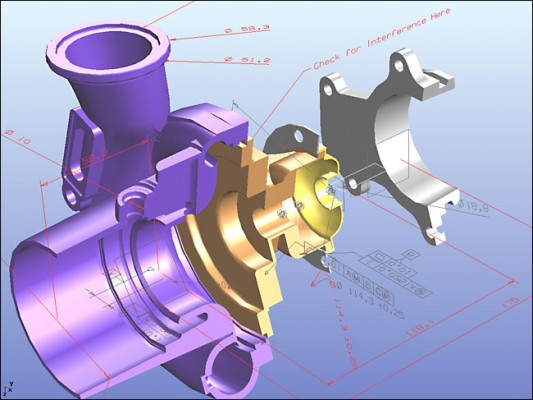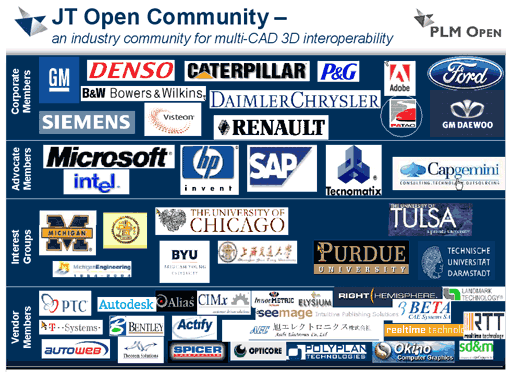Sharing 3D product data with rich detail and a light data footprint has been the Holy Grail of design automation for a generation. In this article from Engineering Automation Report, March 2007, analysts suggest JT has the potential to become “a true industry leader.”
By Rachael Dalton-Taggart
Engineering Automation Report, March 2007—On January 8, 2007, UGS announced it was publishing the JT Open data format in a move it described as “the next logical step in establishing a common language that allows the global manufacturing industry to seamlessly share and retain 3D product data.” The announcement definitely got industry tongues wagging and, it turns out, seems to be a move generally applauded across the CAD/CAM market. On further investigation, we believe this is not just a bold move by UGS but also one that will turn JT into a true industry leader.

JT Open has been around for ten years and has witnessed a good deal of success, albeit mostly in the automotive industries where UGS has a stronghold of users. In 2003, UGS founded the JT Open Program which allows its members access to a toolkit to support JT formats in their own software. The JT Open program requires approved membership and payment of royalties, and will continue in the same form. (JT Open members only pay royalties on the JT-enabled applications they sell to non-JT Open members.) However, by openly publishing the format (available at http://www.jtopen.com/technology/format_reference.shtml), anyone who wants to create their own JT format libraries can now do so, free of obligations or royalties.
Instead of trusting simply the comments and gusto in UGS’ press release, we went out to a few industry insiders to get their point of view. First from an analyst. Ken Versprille, Ph.D., is PLM research director for CPD Associates: “The openness and maturity of the JT data format places UGS at the forefront in providing solutions that empower sharing 3D product data. The industry’s extensive adoption of JT testifies to its power and flexibility for product visualization and collaboration.”
Okay, I think Dr. Versprille likes it. Now let’s see what a competitor has to say. Lattice Technology offers the competing XVL format for 3D data. General Manager Bill Barnes says, “…I think this is testament to growth of the use of 3D data in many applications downstream from CAD that JT has joined the other formats [PDF, DWF] that provide open versions. As we have seen from many of our customers, the size of the file is still key to successful enterprise use. We will continue to make our ultra compressed XVL format available via our developer programs, which include the ability to license the XVL Kernel.” Well, Barnes isn’t ready to send his resume to UGS, but that’s an affirmation, too.
Why do we need common 3D formats?
One of the most common complaints we hear from engineers is that problems still exist in sharing, viewing, and, most important, reusing 3D data. Furthermore, 3D CAD solid and surface models are often data-intensive, resulting in files that can be extremely large and way too bulky to be easily shared without massive broadband support. JT, along with a number of other 3D data formats (including 3D PDF, XVL, DWF and Seemage), tackle this problem in various ways, and all aim to be able to communicate 3D data without the overhead usually associated with native 3D CAD files. The development of these various 3D publishing formats turned into a hotly contested market about three years ago.

With the exception of PDF and DWF, all these formats have remained proprietary. If a developer wants to support a format, it means buying in to the trade secrets behind it. Generally, this means greater expense for the developer, which will always be passed on to the user. Now that JT has published its format, it means that there potentially will not be greater costs involved and that the JT format will be perceived as non-proprietary—a data format we can all read without buying more software first.
But how does UGS make money from this?
UGS took a page from the Adobe playbook on this. Back in 1994, Adobe documented and published the PDF format—making it open to anyone who wanted to use it. And it was around that time the company started making money from the Adobe Acrobat software that could help write documents into the PDF format (source: http://www.prepressure.com/pdf/history/history01.htm). In addition, Adobe also provided its own member-only PDF toolkit, with royalties, providing developers with immediate access to the PDF libraries. In addition, other independent PDF file libraries have been formed that only help with building the market.
The resulting take-up of PDF as a standard format for document exchange is unarguably an industry success, one from which many developers can learn. And this is, we believe, precisely what UGS is doing. They are continuing the JT Open Program. When asked for clarification, Jim Phelan replied: “The 250-page reference document fully defining the JT format is published and openly available to everyone for free download at http://www.jtopen.com/technology/format_reference.shtml. Membership in JT Open is not required. At the same time, membership in the JT Open Program continues to provide additional benefits to its members such as direct influence into JT?s ongoing development, access to UGS’ JT Software Development Toolkit and royalty free licensing of JT-enabled applications to other JT Open members.” UGS indicated that they were not aware of any independent bodies that would use the published format as yet, but that was a possibility they were aware of.
When we asked Adobe why they published the PDF specification in the first place, and continue to do so now, Bahman Dara, Adobe Acrobat 3D Senior Product Manager said, “Doing this is a good way to develop competition, and that is healthy for the users and the market. As PDF is the world?s most widely used format, we know our actions have been appropriate.”
And this affects us how?
Over time, the unleashing of the JT Open data format will give engineers a new choice. Adobe’s 3D PDF, a major player in the 3D communication market, is already documented as part of the published PDF specifications (including its support for U3D as an intermediary format). According to Dara, “The newly-added PRC intermediary format acquired as part of our TTF acquisition last year will be included in the upcoming PDF 1.7 specification, and we anticipate that we will see this as part of the PDF/E standards for engineering data in PDF.” Do remember, almost everyone supports PDF in one way or another. By documenting 3D PDF, this heavyweight will continue to dominate the market. There has been a rap against the first implementation of 3D PDF—the files are huge. Because the next version of Acrobat 3D is not set to ship until March or April, we have yet to see how the addition of PRC support will help. File compression may well continue to be a competitive differentiator.
For the record, Autodesk’s DWF format is also published and available for download.
Even the curmudgeonly Evan Yares, industry commentator and former executive director of the Open Design Alliance, mostly agrees with UGS’ move: “UGS’ JT file specification appears to be an honest attempt to ‘do the right thing’ for customers, by providing an insurance policy for long-term access to JT format files. But it begs the question: why won’t the others do the right thing for their customers too?”
Openly publishing JT Open brings new options to users. It means more software products will support JT in the near future—and support it well and cost-effectively. The availability gives engineers an additional choice in exchange formats and perhaps helps level the competitive playing field. Competing developers should take note of this before JT establishes an insurmountable lead.





